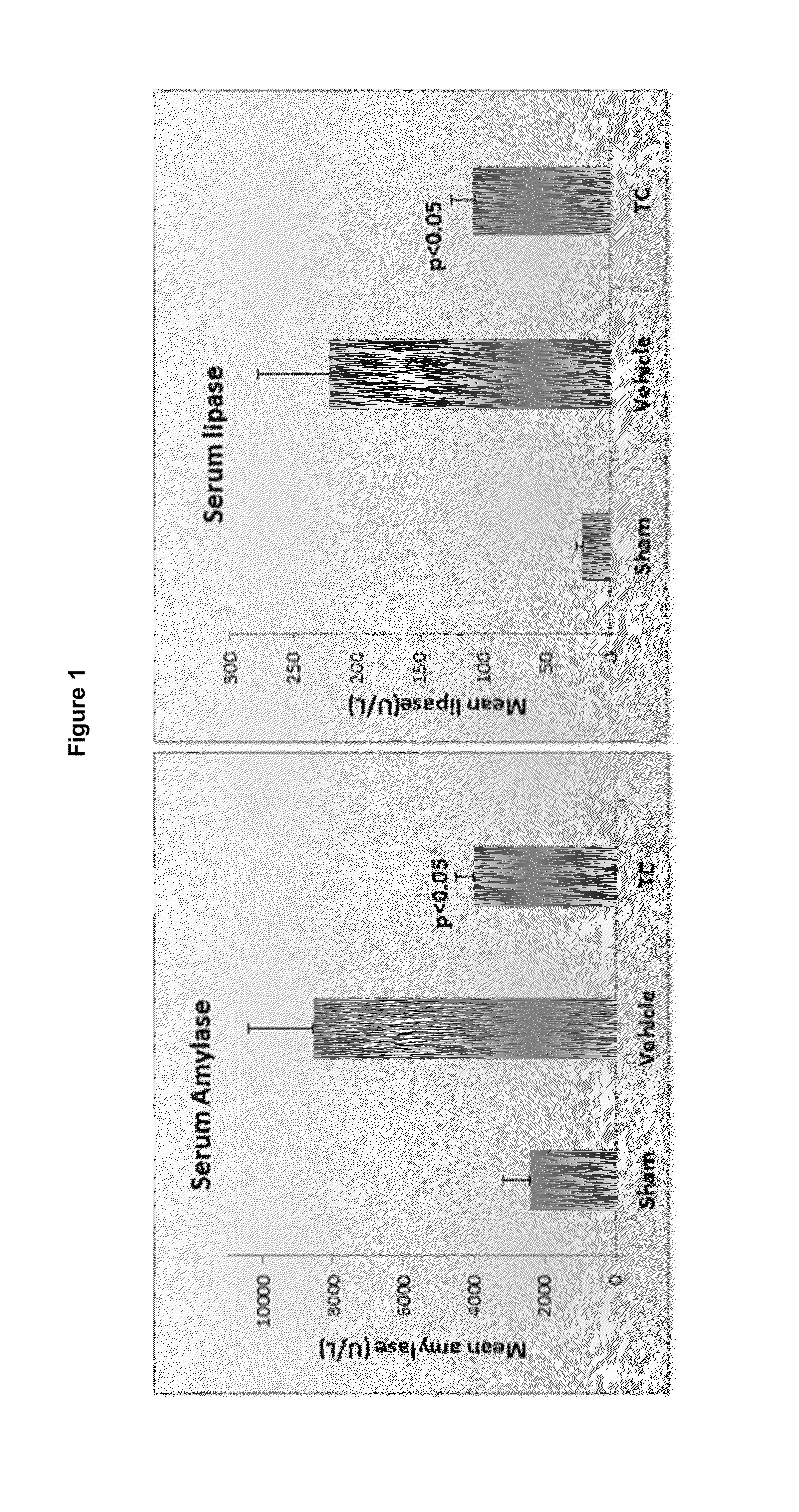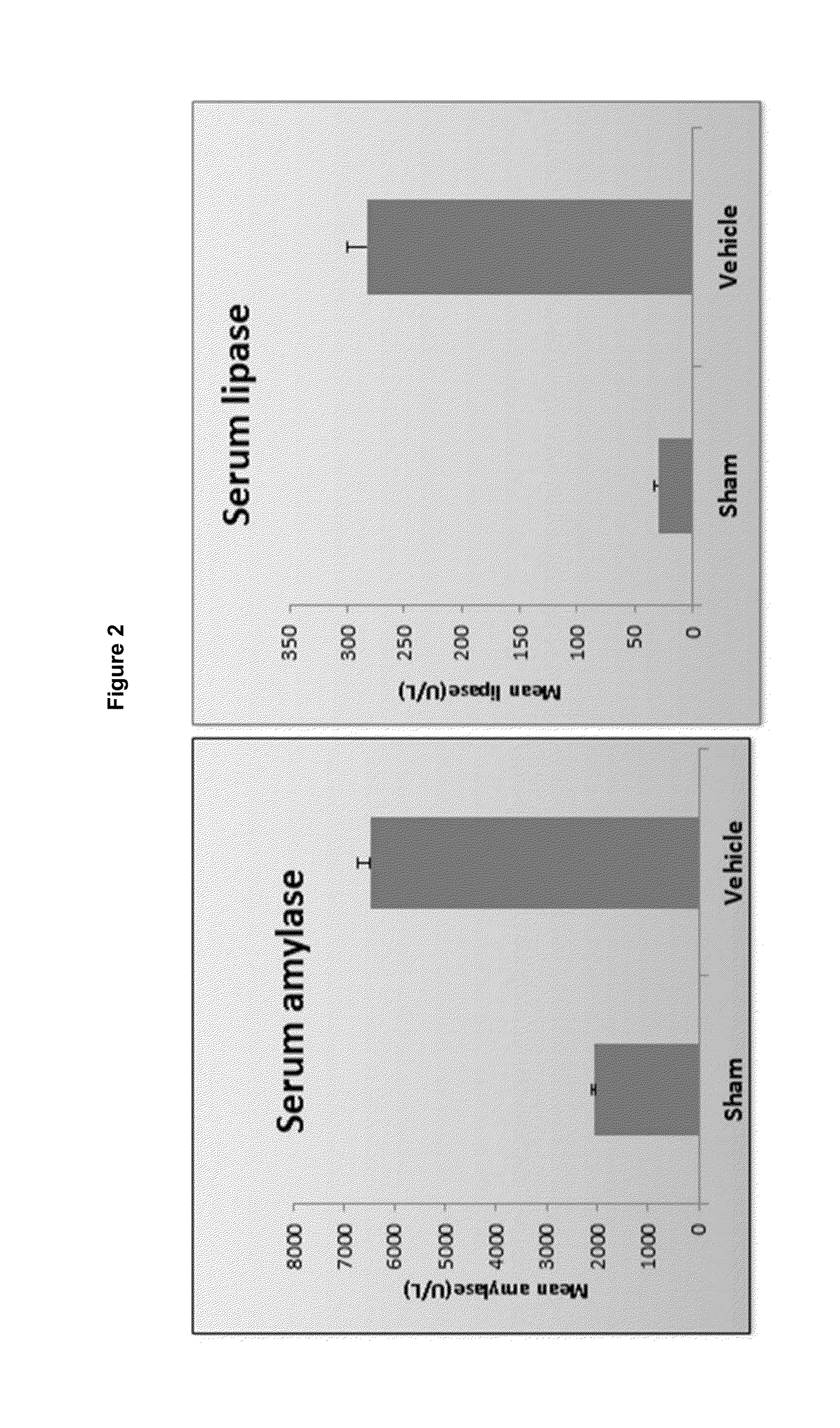Small molecule Anti-fibrotic compounds and uses thereof
a small molecule, anti-fibrotic technology, applied in the field of small molecule anti-fibrotic compounds, can solve the problems of destroying lung structure and function, no effective treatment for this devastating illness, and affecting the health of afflicted individuals, so as to prevent, treat or lessen the severity of a condition.
- Summary
- Abstract
- Description
- Claims
- Application Information
AI Technical Summary
Benefits of technology
Problems solved by technology
Method used
Image
Examples
example 1
Treatment with Test Compound (TC) Attenuates Cerulein-Induced AP in Mice
[0462]Acute Pancreatitis (AP) in mice was induced by cerulein (Sigma) at 75 μg / kg / bw. Cerulein was given 8 times in a day via intraperitoneal (IP) injections in 100 ul of saline. The sham group received an equal volume of saline (n=4). Vehicle or TC (50 mg / kg, IP, twice / day, n=14 / group) were given just 30 minutes prior to the first cerulein injection. Mice were sacrificed after 24 hrs of treatment and blood was collected to determine serum amylase and lipase levels in each group. As shown in FIG. 1, serum amylase and lipase levels were decreased significantly (p<0.05) with the TC treatment compared to vehicle cohort.
example 2
Therapeutic Treatment with Test Compound (TC) Attenuates Cerulein-Induced AP in Mice
[0463]Acute pancreatitis (AP) in mice was induced by IP injections of cerulein at 75 μg / kgbw. Some animals (n=6) were sacrificed after 2 hours of cerulein before the treatment of vehicle or TC was initiated to verify that AP was induced; serum amylase was elevated more than 3-fold and lipase was elevated 8 fold (FIG. 2) in 2 hours.
[0464]In another experiment, vehicle or test compound (TC-50 mg / kg, IP, twice / day, n=15 / group) were given starting 2 hr after the first cerulein injection, and sacrificed after 24 hrs of treatment. Pancreatic edema, as well as serum amylase and lipase levels, were decreased significantly (p<0.05) with the TC treatment compared to vehicle as shown in FIG. 3.
example 3
Test Compound Inhibits TGFbeta1-Induced Collagen Production in Pulmonary Fibroblasts
[0465]To determine the effect of test compound on collagen production in vitro, we tested the effect of the test compound on TGFbeta1-induced collagen production in pulmonary fibroblasts. For this, human lung fibroblasts (HFL1, ATCC Catalog CCL-153) were plated in 24-well micro-well plates (100,000 cells per well in 500 μL volume) and starved overnight. Cells were then treated with TGFbeta1 (10 ng / mL final concentration) and test compound (1 μM final concentration) or controls. After two days of incubation, the collagen production in the supernatant was determined using the Sircol Collagen Assay. We found that the test compound significantly inhibited the TGFbeta1-induced collagen production in human pulmonary fibroblasts (FIG. 4).
PUM
| Property | Measurement | Unit |
|---|---|---|
| body weight | aaaaa | aaaaa |
| pH | aaaaa | aaaaa |
| pH | aaaaa | aaaaa |
Abstract
Description
Claims
Application Information
 Login to View More
Login to View More - R&D
- Intellectual Property
- Life Sciences
- Materials
- Tech Scout
- Unparalleled Data Quality
- Higher Quality Content
- 60% Fewer Hallucinations
Browse by: Latest US Patents, China's latest patents, Technical Efficacy Thesaurus, Application Domain, Technology Topic, Popular Technical Reports.
© 2025 PatSnap. All rights reserved.Legal|Privacy policy|Modern Slavery Act Transparency Statement|Sitemap|About US| Contact US: help@patsnap.com



